What is the numbered fast break in basketball
The numbered fast break is a basketball offensive strategy in which each of the five players, during transition offense, are assigned distinct numbers and given specific roles related to those numbers with the main objective of creating quick scoring opportunities near the basket or near the perimeter areas of the court.
Why is the numbered fast break a potentially effective system
The numbered fast break could be a potentially effective system because it typically provides a predetermined plan in reference to the primary break and/or secondary break phases within transition offense as opposed to the standard fast break, which focuses more on improvisation between the players.
Why is the standard fast break a potentially ineffective system
In a standard fast break system, regardless if it is a 2-on-1, 3-on-2, or 4-on-3 advantage, the offensive players might not be on the same page in reference to each other’s strengths and weaknesses.
More particularly, if those same offensive players are going too fast and/or they are indecisive of what their teammates want to accomplish, then that could lead to lower quality shot attempts, no shot attempts at all, and/or unnecessary turnovers during the perceived advantage.
What are possible situations in which the standard fast break could become ineffective
In each of the standard fast break situations below, it is a 2-on-1 primary break scenario in which two players, Player A and Player B, have an advantage against one defender that is backpedaling to protect the basket.
Furthermore, in each situation, Player A has the ball near the top and is dribbling towards the basket while player B is on the wing. Additionally, for demonstration purposes, it does not matter if Player B is near the left side or right side wing.
Situation #1
In the first situation, if Player B is typically a three-point shooter but this same player decides to cut in towards the basket during the fast break advantage, then Player A might become confused and/or indecisive in giving the ball to the Player B near the rim.
When that occurs, Player A might miss the timing window to pass the ball to player B, which in turn, would generate a scoring opportunity for Player B directly at the basket.
Instead, Player A might decide to take a jump shot or drive the ball to the basket themselves against the defender that is attempting to protect the basket.
The problem though, is that both of those scoring options from Player A are usually lower quality shot attempts within a transition offense/fast break advantage.
Situation #2
In the second situation, Player A does indeed pass the ball to the Player B near the basket.
However, because Player B is not known for finishing at the rim as opposed to shooting three-point jump shots, that same player could completely miss the layup or unnecessarily alter the layup in mid-air due to the real or imagined defensive pressure from the defender that would be protecting the basket.
If that were to occur, then those types of shot attempts from Player B may as well be considered lower quality shot attempts.
Situation #3
In the third situation, Player A expects Player B to remain near the perimeter, particularly behind the three-point line, but Player B decides to cut in towards the basket instead.
However, during the time of that cut in, Player A passes the ball towards the perimeter where Player A expected Player B to remain at.
This, in turn, basically means that Player A throws the ball behind Player B, which then leads to an unnecessary turnover for the offensive team during the 2-on-1 advantage.
This situation is not very common but it could possibly happen, especially if the two teammates are inexperienced and/or have inadequate chemistry between each other.
Situation #4
In the fourth situation, Player B cuts in toward the basket but Player A misses the timing window to pass to Player B, similar to the first situation.
However, instead of taking the shot or driving to the basket against the defender, Player A waits on the other teammates and decides to execute the team’s half court set plays or motion/continuity offense.
In other words, Player A was indecisive in giving the ball to Player B near the basket and at the same time, Player A was not confident enough (or at least certain enough) to take the jump shot or drive the ball to the basket.
Therefore, as a result, player A essentially prevents the opportunity to score during the standard fast break.
The good news is that Player A did not necessarily take a lower quality shot or turn the ball over during the advantage.
Unfortunately, the bad news is that by waiting for the other offensive teammates, this will more than likely give the defensive team the opportunity to set up their respective strategies.
From that point, it would almost certainly be much more challenging for the offensive team to score against five defenders as opposed to four, three, two, or one defender as within the standard fast break advantage.
Is the numbered fast break better than the standard fast break
Ultimately, the numbered fast break is not necessarily better than the standard fast break.
However, the numbered fast break could be very beneficial for teams that prefer a premeditated plan of action as opposed to spontaneity, especially during the primary break (and in some instances, the secondary break phase) of transition offense.
Also, the numbered fast break could possibly be more useful than the standard fast break if the team is generally inexperienced and/or they are not very familiar with each other’s strengths and weaknesses.
Furthermore, if each of the five offensive players on the court have very specific strengths and/or weaknesses, then the numbered fast break could be a more viable option than executing the standard fast break.
Conversely, the standard fast break might be more feasible than the numbered fast break if the offensive players have great chemistry and they are aware of each other’s strengths and weaknesses.
Moreover, if at least a few of the five players have enough offensive versatility which allows them to score near the basket or from the perimeter, especially behind the three-point line, then the standard fast break might be more beneficial than the prearranged numbered fast break.
What are the typical numbers and roles of the players within the numbered fast break
These are the numbers and roles of the five players within the numbered fast break staring with Player 1.
However, it is possible to have some variance, especially with player actions, primarily based on team personnel and/or coaching philosophy.
For example, if player 4 is a better three-point shooter and player 5 is a better low post player, then player 4 could generally stay near the slot on the perimeter while player 5 almost exclusively runs to the rim and then to the low post area.
Player 1 – Point Guard
Player 1 is the point guard and their primary role is to dribble the ball down the court quickly, typically near the slot areas, and then pass to other teammates that are open.
Generally speaking, player 1 would prefer to execute a pitch ahead pass to player 2 or throw a cross court pass to player 3 as the first scoring options during the numbered fast break.
Player 2 – Shooting Guard
Player 2 is the shooting guard and their main role is to run very wide down the sideline (usually on the right side of the court) to the corner and have their hands ready to receive the ball from player 1.
Also, if player 2 does indeed receive the ball from player 1, then player 2 could go ahead and take the quick jump shot if it is open.
Player 3 – Small Forward
Player 3 is the small forward and their primary role is to also run very wide down the sideline (usually on the left side of the court) to the corner, similar to player 2.
However, player 3 also has the option to cut in towards the basket, generally near the low post block. From that point, player 3 could look to receive the ball from player 1.
Player 4 – Power Forward
Player 4 is the power forward and their general role is to run parallel to player 1 in the opposite slot towards the three-point line.
However, player 4 also has the option to first, run to the rim, and then second, cut through to the low post block on the same side as player 1.
Player 5 – Center
Player 5 is the center and their typical role is to grab the rebound if the opposing team misses a shot attempt or to quickly get the ball out of the net if the opposing team makes a shot.
Following that, the center will either execute an inbound pass (on a make) or simply throw an outlet pass (on a miss) to the point guard.
From there, the center will usually trail behind all of the other players and eventually settle near the low post block on ball side or remain near the perimeter, which is generally dependent on the action of player 4.
Affiliate Disclosure: I may earn a commission on qualifying purchases made through the links below.
What is an example of the initial formation and actions within the numbered fast break
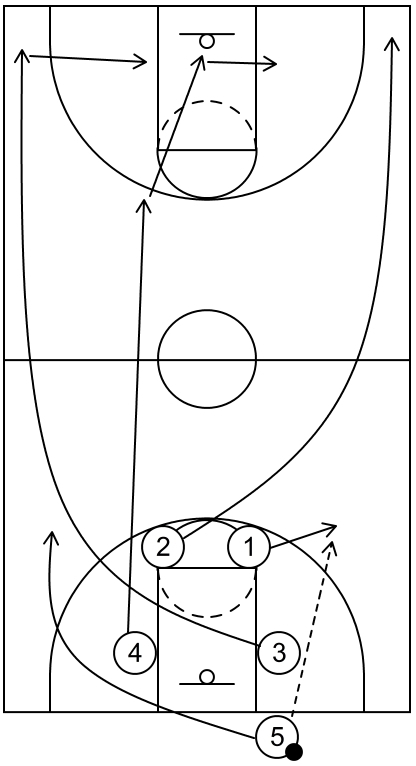
This is an example of the initial formation and player actions within the numbered fast break and this example also assumes that the opposing team just scored. So, therefore a player will inbound the ball.
Furthermore, this initial formation, the player actions, as well as the scoring options below are mostly based on Basketball in The Fast Lane by Paul Westhead.
It should also be noted that Coach Westhead popularized the numbered fast break, particularly during his time as the head coach of the Loyola Marymount (LMU) men’s basketball team, and it was typically known as “The System”.
Before beginning the action, players 1 and 2 are near the high post elbows while players 3 and 4 are near the low post blocks. Additionally, player 5 took the ball out of the net after the other team scored and will therefore, inbound the ball.
Following that, to start the action, 1 breaks out beyond the backcourt three-point line on the same side as the ball and receives the inbound pass from 5.
As that occurs, 2 sprints down the right sideline to the right side corner while 3 sprints down the left sideline towards the left side corner.
Alternatively, 3 could also cut towards the basket near the left side low post block as well.
At the same time, 4 sprints down the court parallel to 1 in the opposite slot. Additionally, as an alternative option, 4 could run to the rim and then cut through to the right side low post block.
Last but certainly not least, 5 will trail the fast break behind the other players and then 5 will act accordingly, mainly depending on the action of 4.
What is an example of the primary scoring options within the numbered fast break
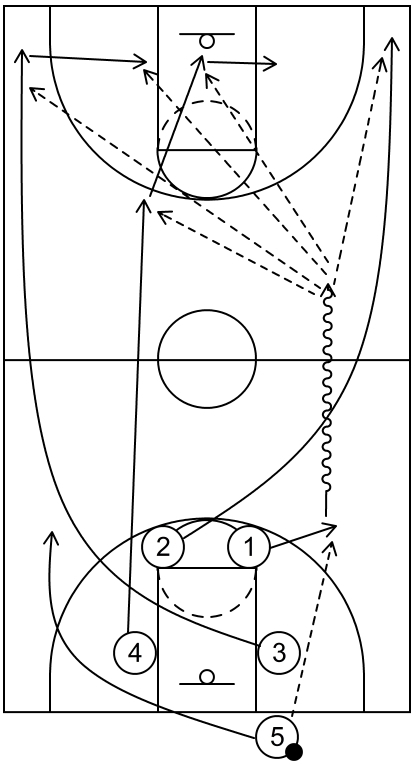
This is an example of the primary scoring options (and essentially, the primary break) within the numbered fast break after the opposing team scored a basket.
However, before passing the ball to other teammates breaking out down the court, 1 would usually take up to three dribbles to either get the ball into the frontcourt or at least get as close to the frontcourt as possible.
What this does is give 1 a better passing angle for throwing the ball to the other teammates.
To start, the first option is for 2 to receive the ball from 1 and then take the three-point shot if that is open.
The second option is for 3 to receive the ball near the left side corner and then, 3 could take the open three-point shot.
Furthermore, as for the third option, if 3 decides to cut in towards the low post block, then 3 could receive the ball and score near the basket.
If 2 or 3 are not available, then 4 could receive the ball near the left slot and shoot the three-point shot if open as the fourth option.
Also, as the fifth option, 4 could run to the rim, receive the ball from 1, and score at the basket.
If that is also not available, then 4 would continue through to the right side low post block. From that point, 1 would continue to dribble the ball into the frontcourt near the three-point line and then the offense would move into the secondary scoring options.
What are examples of the secondary scoring options within the numbered fast break
Example 1
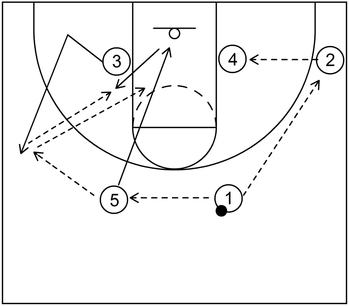
This is an example of the secondary scoring options (and basically, the secondary break) within the numbered fast break in which 4 cut through to the right side low post block and 3 also cut through to the left side low post area.
When that occurs, 5 could fill the left side slot area after trailing in the backcourt.
Next, 2 would receive the ball from 1 if that is open and then, 4 could receive the ball from 2. Afterwards, 4 could score near the basket with a low post move.
Alternatively, if 2 is not open, then 5 could receive the ball instead. Following that, 5 could take the open three-point shot if 5 has the ability to do so.
Also, 3 could receive the ball from 5 as well via reversal action after executing a v-cut to get open near the left side wing area.
From that point, 5 could cut to the basket, receive the ball again from 3, and score at the rim. However, if 5 is not open on the cut, then 5 could fill the left side low post block.
After that, 5 could receive the ball from 3 and then attempt to score with a low post move.
Example 2
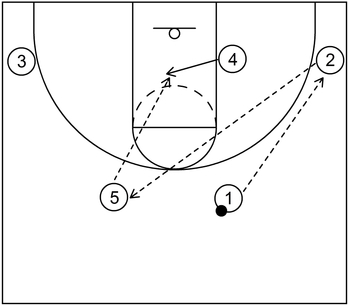
This is an example of the secondary scoring options in which 4 cut through to the right side low post block but 3 remained near the left side corner. When that occurs, 2 could receive the ball from 1 and take the jump shot if open.
However, if 2 is not open to take the jump shot and at the same time, 4 cannot receive the ball, then 2 could execute the skip pass to 5.
Following that, 5 could take the three-point shot if open. Also, if 5 is not open to take the shot, then 4 could cut into the lane and receive the high low pass from 5.
Afterwards, 4 could score near the basket with a field goal attempt such as a hook shot.
Example 3
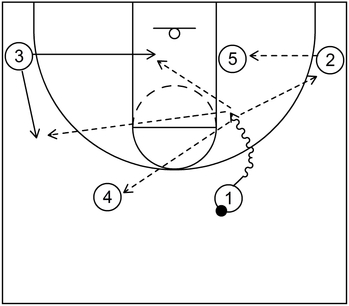
This is an example of the secondary scoring options in which 4 stayed near the left slot area and 3 stayed near the left side corner.
When that occurs, 5 would run to the rim and then fill the right side low post area after trailing behind the fast break in the backcourt.
Next, 1 could execute dribble penetration towards the basket, score at the rim, or simply pass to one of the other teammates.
If 2 receives the ball from 1, then 2 could take the jump shot if open or execute the post entry pass to 5. Afterwards, 5 could attempt to score with a low post move.
Additionally, if 1 dribbles toward the basket and 3 is near the left corner, then 3 could cut to the basket. From there, 3 could receive the ball from 1 and score at the rim.
Alternatively, 1 could dribble towards the basket and then 3 could lift to the left side corner. Once that happens, 3 could receive the ball from 1 and then, take the open three-point shot.
Furthermore, 1 could get dribble penetration and simply pass to 4. From that point, 4 could take the open three-point shot.